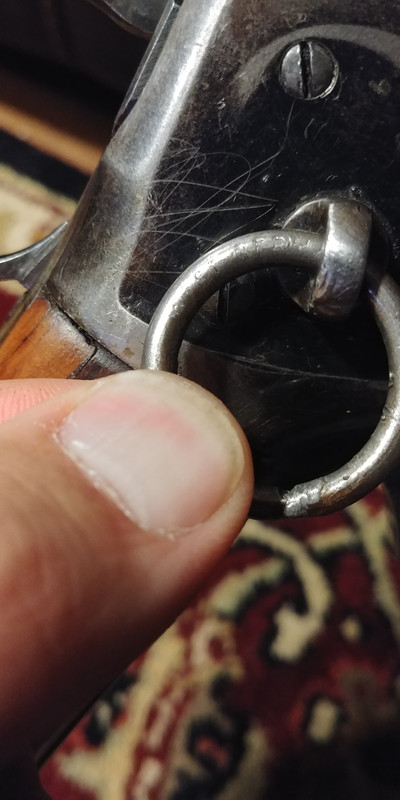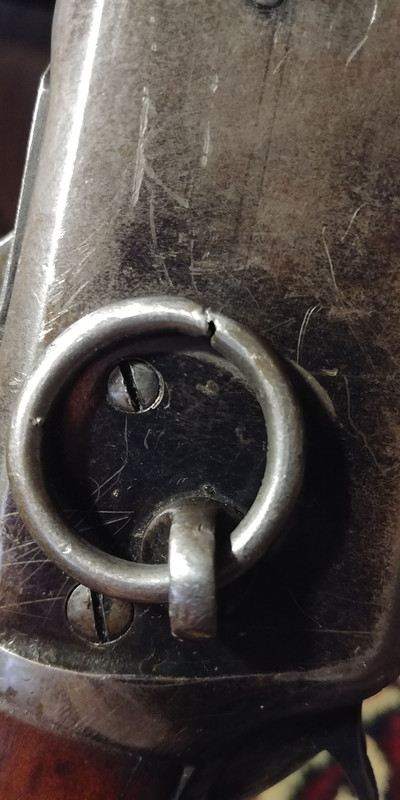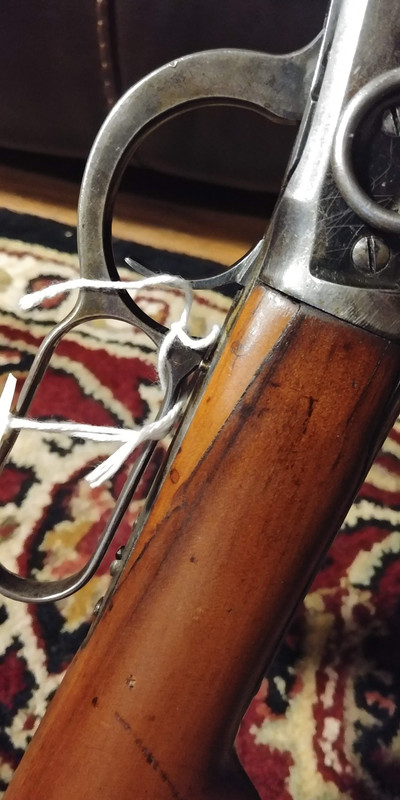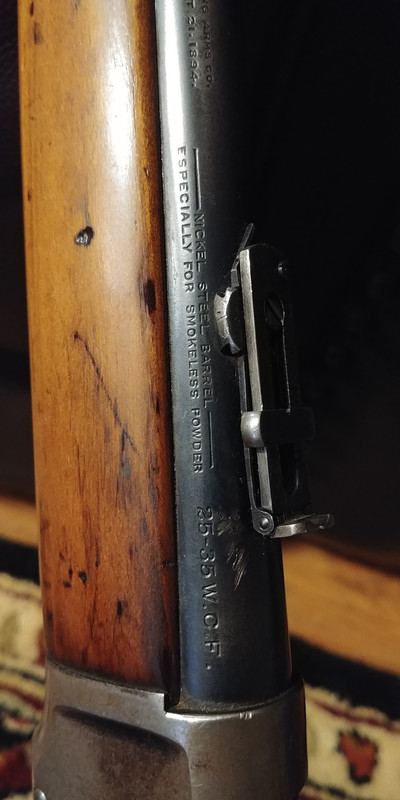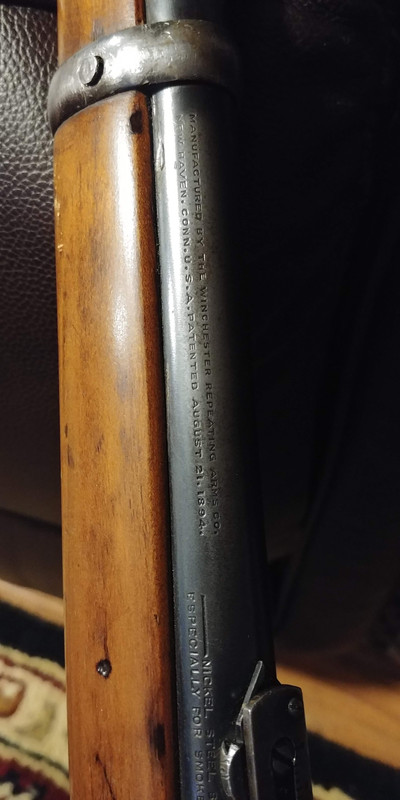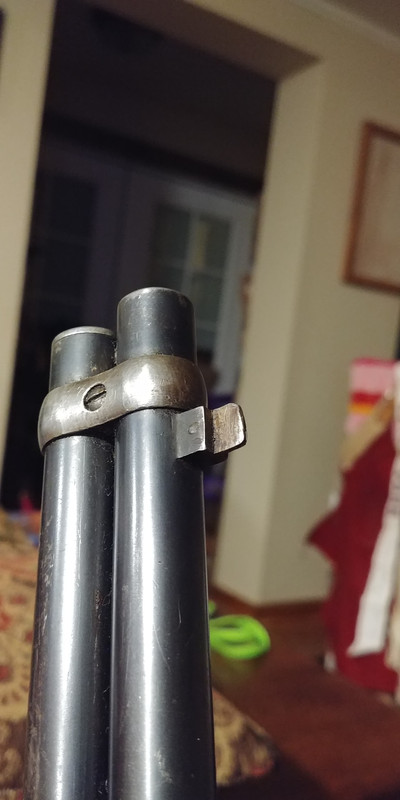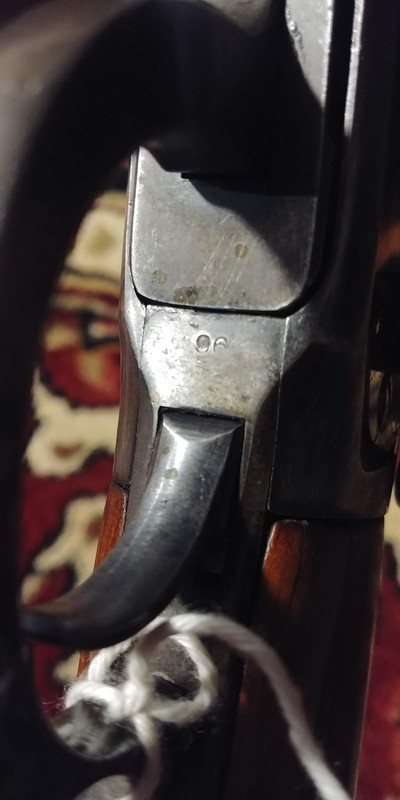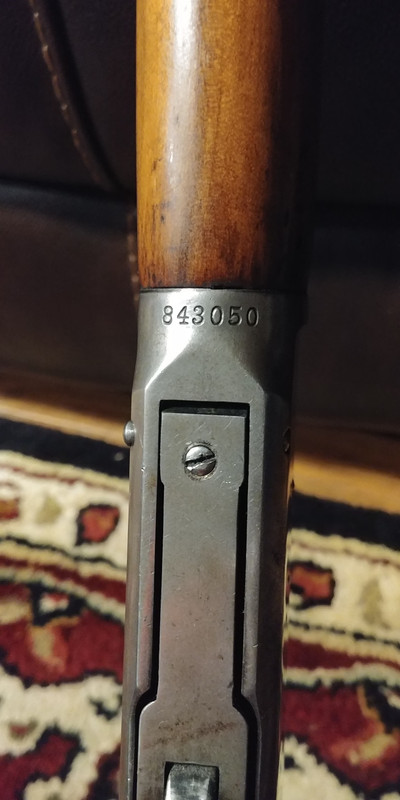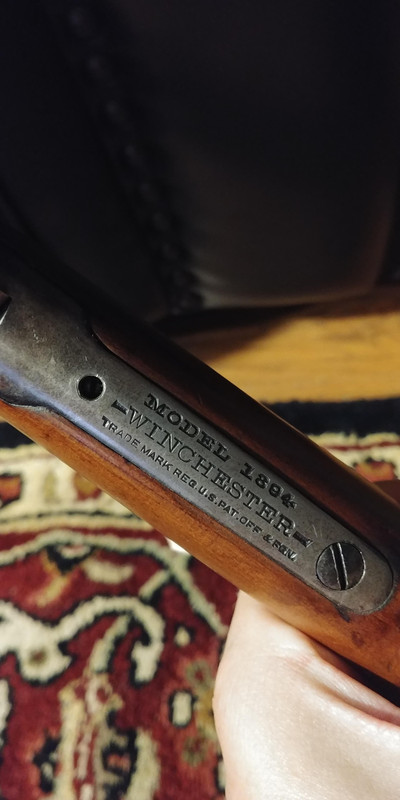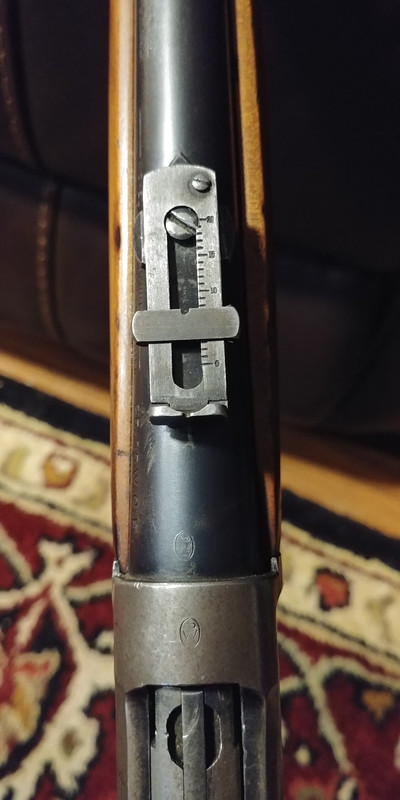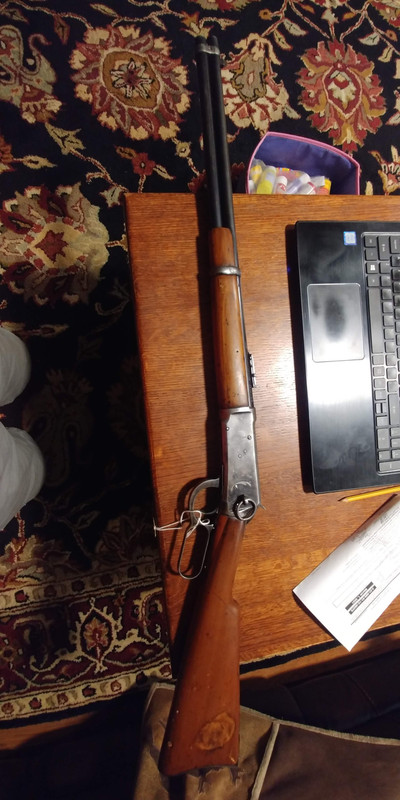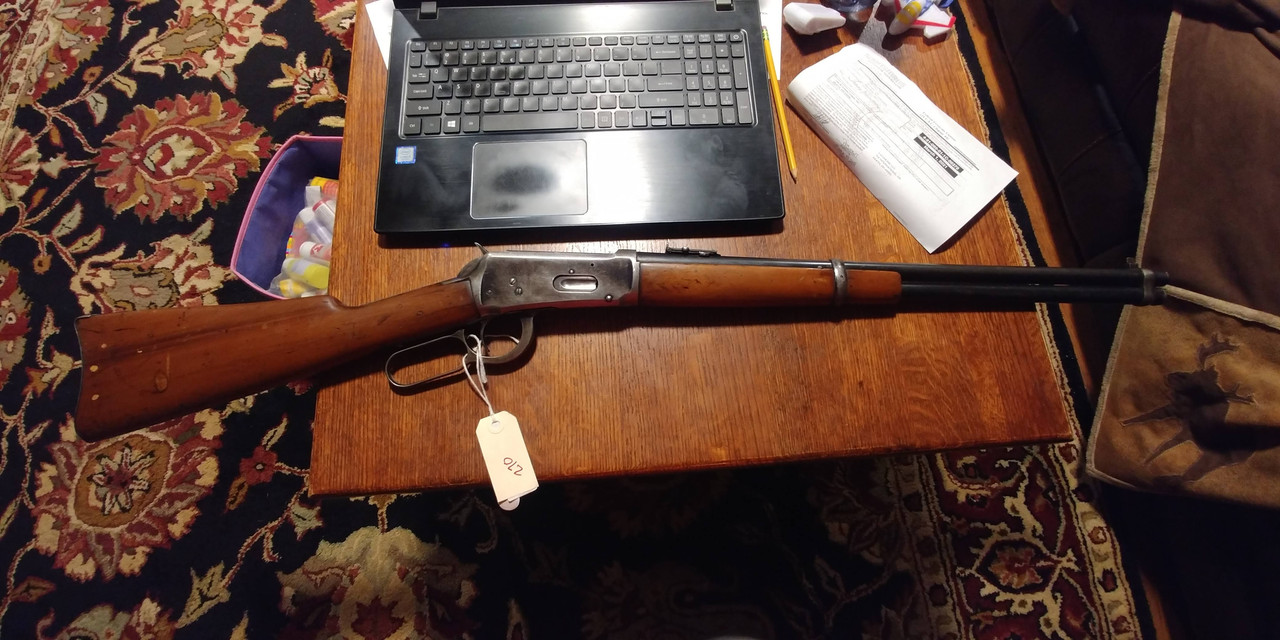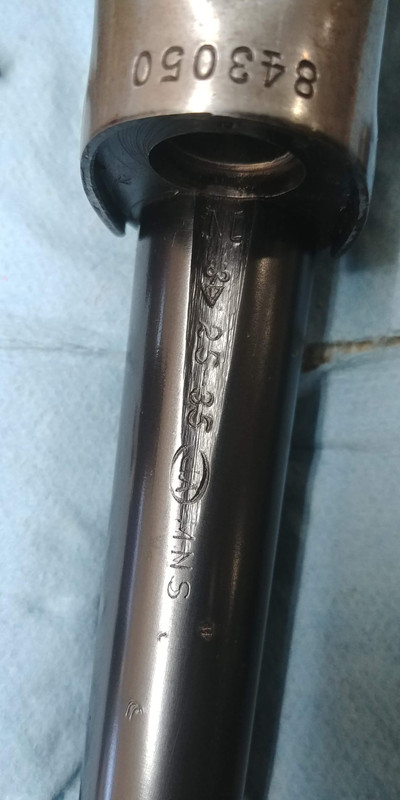Hey all, trying to figure out exactly what I’ve got here.
Recently attended the Betty Whiteside Estate Auction in Loveland, CO, and came away with what I think is a great looking 1894.
Serial Number 843050, SRC in 25-35. It has the flip up rear sight with the half moon, not V notch. Marks @ 0, 5, 10, 15, 20.
The rear barrel band screw has been replaced with a well-worn trim nail.
There’s * a lot of * evidence that at some point the stock has been heavily sanded and then refinished (wood is no longer proud of the butt plate, wood filler, and a splice repair above the lever), and I believe the barrel has been replaced as well based on what look like pipe wrench marks seen under the Patent information. Bore is in good condition, barrel hasn’t been reblued and is showing grey in some areas (namely along/above the patent marks). Marked “Nickel Steel Barrel” The pics are high contrast, the patina is really nice. YEs, the barrel is more “blue” than the greyish receiver/lever.
Tons of character on this one, plenty of wear near the saddle ring.
Saddle ring seems to have some sort of roll mark / stamp. I can’t make it all out. First word looks to be “WEST”. Also, the ring doesn’t come together flush, with straight cut ends, if that makes sense. Given the amount of wear, I’m not sure the ring hasn’t been replaced with a non-stock piece at some point? It’s soldered at the ring joint. (Edit: It’s possible this is a pistol cleaning rod ring that’s been cut from the rod. There are two different ring halos. The second word could be “GERMANY” – the letter count would be correct.)
Bert I appreciate it.
A couple follow ups, if I may…
Serial number on the sites I found put this one as made in 1919, do you believe that is correct? And in this case, then, the barrel was swapped later with a “somewhat close” year barrel? The pipe wrench marks are solid/distinct, so I’d imagine at the very least the barrel has been removed.
Is there any way to see if the gun was originally a 25-35 as marked now or if that was changed with the barrel? (Ie can receiver parts be replaced easily to accommodate the different calibers)
How often do folks find homemade replacements for the saddle rings?
What would the original finish on that gumwood have been? Linseed? Tung?
Given the age and “ranch history” of the gun, what do each of those “modifications” do to the general value? I own it now, so there’s no going back, but I would love the info.
Again, thank you.
CoRifleman said
Bert I appreciate it.A couple follow ups, if I may…
Serial number on the sites I found put this one as made in 1919, do you believe that is correct? And in this case, then, the barrel was swapped later with a “somewhat close” year barrel? The pipe wrench marks are solid/distinct, so I’d imagine at the very least the barrel has been removed.
Again, thank you.
Nearly all of the websites that list Winchester DOMs based on the serial number have erroneous information on them. Your Model 1894 was not manufactured in the year 1919. We offer a Winchester serial number look-up tool here on the WACA website that uses the original Winchester factory serialization records, and will show you the correct year of manufacture – https://winchestercollector.org/dates/ If you desire that exact date of manufacture, the Cody Firearms Museum records office offers a date of manufacture letter ($40 for non-members) – https://centerofthewest.org/explore/firearms/firearms-records/
In regards to the pipe wrench marks on the barrel, they do not necessarily mean that the barrel has been replaced or even removed. You would be surprised at how many “Bubba’s” have tried to take a barrel off of the receiver and were not smart enough to open the lever far enough to clear the extractor from milled slot in the barrel, and then gave up when they could not get the barrel to turn.
As I previously mentioned, the factory markings that are on the barrel of your gun are correct for a 1917 vintage Model 1894 SRC. Furthermore, the serial number on your 25-35 WCF SRC is right in the middle of a batch of several other SRCs in the same caliber, which leads me to believe that the barrel is original to the gun.
Bert
WACA Historian & Board of Director Member #6571L
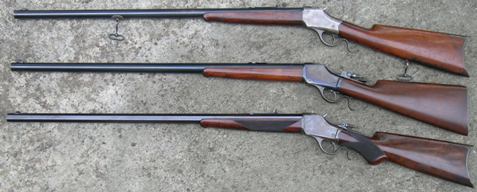
Again, appreciated.
I’ve got an original main spring screw on the way, and a correct rear barrel band and screw on the way. I’ll keep the stuff that was with the gun when I bought it, but those two items have been replaced with incorrect parts (the nail, which even though it’s been ground smaller at the far end to fit, still gummed up the threads to the point of no return on the barrel band) and the main spring screw is obviously a newer screw (all silver, no taper under the head at all, and much too long).
Here are the marks from under the barrel.
patrick tompkins said
yea that gun has some stories to tell, But my only observation is in line with what Bert said. Saddle Ring at a glance seems to be a lil larger in circumference than that of an original saddle ring.
Yes, I realized the ring was wrong once I saw stamped lettering on it (I’m obviously not a 94 expert), plus, you’re right, there are two halos… one probably where the original ring was, and then the start of another one with this rings circumference.
Bert, if you don’t mind, what’s led to the proliferation of incorrect dates? Seems like there should be one accurate source, with that information used to create all other databases. What gives?
CoRifleman said
Bert, if you don’t mind, what’s led to the proliferation of incorrect dates? Seems like there should be one accurate source, with that information used to create all other databases. What gives?
The “proliferation” occurred in the early days of the internet, and it was the direct result of nearly everyone mistakenly copying the information originally published by George Madis. For some unknown reason, George Madis was apparently completely unaware of Winchester’s Polishing Room records. The Polishing Room records (the CFM refers to them as the “SNA” records) list the specific date that the serial number was applied to the receiver or receiver tang for all of the various models. Winchester employee George Hertel was the person who instituted the records in the year 1885. The record book was used to record the last serial number applied to a particular model on any given day. The are instances where multiple batches of receivers were serialized on the same day, and when that occurred, the last number stamped in each batch was recorded. The Polishing Room records allowed Winchester to track how many of each model were made each day, and provided the starting point (number) for the next batch to be made.
The Models 1892 and 1894 have the largest error margin between the actual production numbers, and the numbers that George Madis published. Where this becomes critical (important) information, is where the “Antique” (pre-1899) versus the “Modern” (post-1898) dividing line actually is. For the Model 1894, serial number 53941 was the last truly “Antique” manufactured. The list below (copied from Chapter 8 in “The Red Book of Winchester Values, 4th edition” are the verified “antique” serial number cut-offs for all the early Winchester models.
| TABLE 3 | |
| Last Serial Numbers | |
| to Qualify as | |
| ANTIQUE pre-1899 | |
| Henry Repeating Rifle | All |
| Model 1866 – Lever-action Rifle | All |
| Model 1873 – Lever-action Rifle | 525750 |
| Model 1876 – Lever-action Rifle | All |
| Model 1883 – Hotchkiss Bolt-action | 84551 |
| Model 1885 – Single Shot Rifle | 82381 |
| Model 1886 – Lever-action Rifle | 118646 |
| Model 1887 – Lever-action Shotgun | 64842 |
| Model 1890 – Slide-action Rifle | 64748 |
| Model 1892 – Lever-action Rifle | 103328 |
| Model 1893 – Slide-action Shotgun | All |
| Model 1894 – Lever-action Rifle | 53941 |
| Model 1895 – Lever-action Rifle | 19567 |
| Lee Navy Straight Pull Rifle | 13679 |
| Model 1897 – Slide-action Shotgun | 63867 |
Bert
WACA Historian & Board of Director Member #6571L

1 Guest(s)


 Log In
Log In Members
Members Home
Home

 Add Reply
Add Reply Add Topic
Add Topic Offline
Offline



